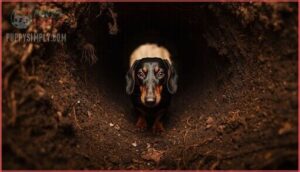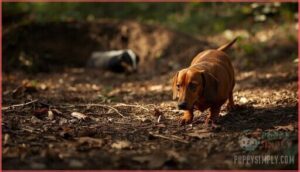This site is supported by our readers. We may earn a commission, at no cost to you, if you purchase through links.

Every feature you see—the elongated spine for maneuvering through tight turns, the paddle-shaped paws for digging through soil, the deep chest for stamina during hours-long hunts—exists because survival underground demanded it.
While most dachshunds today spend their time ruling living room sofas, understanding their hunting heritage explains why your pint-sized companion still digs up your garden and barks at everything that moves.
Table Of Contents
- Key Takeaways
- What Were Dachshunds Originally Bred For?
- Physical Traits Designed for Hunting
- Types and Sizes of Dachshunds
- Key Temperament and Behavioral Traits
- Are Dachshunds Still Used for Hunting Today?
- Frequently Asked Questions (FAQs)
- What is a dachshund dog used for?
- Are dachshunds good hunting dogs?
- Where did Dachshunds come from?
- Are dachshunds easy prey?
- Are dachshunds bred to do?
- What is the history and purpose of dachshund breeding?
- What health issues are common in dachshunds?
- How much exercise does a dachshund need per day?
- What kind of temperament do dachshunds have around children?
- How easy is it to train a dachshund?
- Conclusion
Key Takeaways
- Dachshunds were originally bred in 15th-century Germany as specialized badger hunters, engineered with elongated bodies for maneuvering through tight underground burrows, paddle-shaped paws for digging, and deep chests for stamina during hours-long subterranean pursuits against 30-pound carnivores.
- Every physical trait—from their flexible spine with 20-23 vertebrae enabling sharp turns in narrow tunnels to their 125 million scent receptors detecting odors at one part per trillion—exists because survival in pitch-black underground combat against dangerous prey demanded it.
- While roughly 95% of dachshunds today never see a hunting field and live as companion animals, their DNA still drives persistent hunting behaviors like obsessive digging, relentless barking at movement, and stubborn independence—traits that made them successful solo hunters but can challenge modern pet owners.
- Their distinctive body proportions resulting from selective breeding for chondrodysplasia create serious health vulnerabilities, with 19-24% facing intervertebral disc disease (IVDD) risk—ten times higher than other breeds—making them prone to spinal injuries that directly stem from the same elongated architecture that made them elite badger hunters.
What Were Dachshunds Originally Bred For?
If you’ve ever wondered why dachshunds look the way they do, the answer lies in their original job description. These low-slung pups weren’t bred for show—they were working dogs with a very specific mission.
Let’s look at where they came from, what they were built to hunt, and how their unique design made them perfect for the job.
Origins in Germany
You’ll find that Dachshunds carry a legacy rooted deep in German heritage and hunting culture. Their story began in Germany during the early 15th century, where they earned their place as fierce badger dogs. Here’s what shaped their European roots:
- Early records from the 18th century called them “Dachs Kriecher” (badger crawler) and “Dachs Krieger” (badger warrior)
- The name Dachshund literally translates to “badger dog” in German history
- Original specimens were much larger than today’s breed, weighing 31-40 pounds
- The Hound Group member became formalized when Germany’s first dachshund club opened in 1888
Their breed history centers entirely on badger tracking through dense forests and underground burrows. Understanding the breed history is essential to appreciate their development.
Purpose as Badger Hunters
Badger hunting demanded more than just a willing dog—it required a four-legged warrior bold enough to face 40-pound prey underground. German foresters bred dachshunds to enter dark burrows, confront aggressive badgers armed with sharp teeth and claws, and either immobilize the quarry or drag it out by force.
This wasn’t tracking from a safe distance; it was close-quarters combat in pitch-black tunnels where retreat wasn’t an option. That’s why the AKC describes them as “courageous to the point of rashness”—anything less wouldn’t survive subterranean work against Europe’s fiercest burrowing animal.
Dachshunds were bred for close-quarters combat in pitch-black burrows, where courageous-to-the-point-of-rashness temperament meant survival against Europe’s fiercest prey
The breed’s origins are rooted in badger dog history, which played a significant role in shaping their characteristics.
Development for Burrowing and Tracking
Confronting badgers was only part of the equation—your dachshund needed elite burrowing techniques and tracking methods to reach them first. German breeders refined tunnel navigation skills through selective breeding, prioritizing dogs with relentless scent detection and digging behavior.
These badger dogs followed scent trails through dense forests, then carved through earth and roots to access underground burrows. Their pointed noses tracked prey in lightless conditions while paddle-shaped paws excavated obstacles, transforming hunting from surface pursuit into subterranean warfare against badgers.
Physical Traits Designed for Hunting
Every inch of the Dachshund’s body tells the story of a dog built for underground combat. From their trademark elongated frame to their paddle-shaped paws, these features weren’t accidents of breeding—they were carefully crafted tools for survival in dark, dangerous burrows.
Let’s look at the specific physical traits that made Dachshunds such effective hunters.
Long, Low Bodies for Tunnel Navigation
Think of the dachshund’s body as nature’s perfect tunnel-penetrating tool—elongated architecture meeting functional necessity. Their distinctive silhouette wasn’t accidental; it emerged from deliberate genetic selection favoring chondrodysplasia, a form of dwarfism creating those trademark proportions. This configuration delivered remarkable underground advantages:
- Extended rib cage providing enhanced lung capacity for sustained oxygen intake in confined, low-air burrows
- Flexible spine with 20–23 vertebrae enabling sharp lateral turns within narrow badger tunnels
- Low center of gravity maintaining balance on uneven subterranean surfaces during pursuit
- Body length-to-height ratio averaging 2.2:1 allowing entry into 15–20 cm wide passages
- Aerodynamic contours minimizing snagging on roots and soil projections during forward movement
German foresters recognized that badger dogs needed more than courage—they required bodies capable of weaving through earth’s tightest corridors, confronting quarry where standard breeds couldn’t follow.
Strong Paws and Short Legs for Digging
You’ll notice paddle-shaped paws engineered like soil shovels—broad, oval construction with arched toes that penetrate compacted earth with precision. Those short legs aren’t just adorable; they’re biomechanical masterpieces resulting from chondrodysplasia, delivering 25% greater digging torque relative to body size than terriers. Front paws outsize rear by 10%, optimizing forward thrust during burrow navigation.
German hunters selectively bred dachshunds emphasizing these limb proportions—enlarged flexor muscles and 15% thicker forelimb cortical bone enabled sustained excavation pressure. Their shoulder articulation allows 15 degrees more downward rotation than standard breeds, transforming digging techniques into relentless pursuit machinery. Modern Earthdog trials prove these traits remain—contestants maintain 6–10 minutes of continuous excavation, progressing 0.3 meters per minute underground.
| Anatomical Feature | Functional Advantage |
|---|---|
| Paddle-shaped paws with arched toes | Efficient soil displacement, 40% faster excavation |
| Short legs (achondroplastic limbs) | Lowered center of gravity, enhanced stability |
| Dense paw pads (4–6 mm thickness) | Shock absorption during subterranean adaptation |
Keen Sense of Smell and Hearing
Your dachshund’s olfactory systems pack 125 million scent receptors—detecting odors at one part per trillion, roughly 10,000 times sharper than yours. Auditory acuity reaches 60,000 Hz, capturing ultrasonic prey movements underground.
German breeders perfected sensory integration: elongated noses trap scent particles while floppy ears funnel subterranean vibrations.
This dual-threat hunting instinct enabled badger detection through meters of soil, achieving 90% tracking accuracy in field trials—canine behavior engineered for relentless pursuit.
Types and Sizes of Dachshunds
Dachshunds don’t come in just one flavor—they’re actually split into different sizes and coat types that each bring their own personality to the table. Whether you’re drawn to a sleek standard or a pocket-sized miniature, there’s a look and feel that fits your lifestyle.
Let’s break down the main variations you’ll encounter when choosing your badger dog.
Standard Vs. Miniature Dachshunds
When comparing these two size classifications within the dog breed, you’ll notice stark differences in both physical dimensions and functional purpose. Standard Dachshunds weigh 16 to 32 pounds and stand around 8 to 9 inches tall, originally developed for badger hunting.
Miniature Dachshunds, weighing 11 pounds or less and standing 5 to 6 inches, were bred for pursuing smaller game like rabbits.
Both retain identical breed standards and hunting instincts, though health differences and exercise requirements vary with size.
Smooth, Wirehaired, and Longhaired Coats
Your dog’s coat type reflects centuries of hunting evolution across varied German landscapes. Each variant emerged from deliberate crossbreeding strategies customized to specific environmental challenges and prey types during the breed’s development.
The three coat varieties differ fundamentally:
- Smooth-haired – Sleek, short fur requiring weekly grooming, engineered for dry burrow work with minimal shedding control needs
- Wirehaired – Dense, coarse double coat developed in the mid-1800s through terrier crosses, offering enhanced protection in thorny terrain
- Longhaired – Silky, 5–7 cm hair texture from spaniel ancestry, providing thermal insulation in cooler climates
- Grooming tips – Smooth needs weekly care; wirehaired demands monthly stripping; longhaired requires daily brushing to prevent matting
- Breed standards – All dachshund characteristics maintain identical physical hunting capacities regardless of hair texture, with coat maintenance reflecting original functional demands
Each variety embodies distinct breed characteristics shaped by regional adaptation, yet all conform to the same essential dachshund breed standards for structure and temperament.
Color Variations and Patterns
Coat color genetics transform your dachshund’s appearance through complex inheritance patterns affecting base colors, overlay patterns, and dilution effects. Breed standards recognize primary colors like red, black and tan, and chocolate—complemented by dapple patterns, brindle, and piebald markings that create distinctive visual signatures.
Rare colors including blue (gray) and fawn (Isabella) result from dilution genes, though these variants sometimes correlate with health sensitivities affecting coat quality and longevity. This makes standard colorations preferable in responsible dog breeding programs focused on dachshund breed information integrity.
Key Temperament and Behavioral Traits
Dachshunds don’t just look unique—they think and act like the independent hunters they were bred to be. Their personality reflects centuries of working solo underground, which shaped traits that still show up in your living room today.
Here’s what makes their temperament so distinctive.
Courage and Independence
You’d think a dog barely a foot tall wouldn’t challenge a badger head-on, but that’s exactly what Dachshunds were bred to do. Their fearless nature and brave traits come from centuries of hunting dangerous prey underground—solo work that demanded courageous behavior and independent thinking.
This legacy makes them vigilant watchdogs today, unafraid to sound alarms despite their size. Their hunting instincts fuel both their boldness and loyalty, creating dogs with intelligence that sometimes borders on defiance.
Stubbornness and Intelligence
That independence you just saw? It comes with a catch—Dachshunds rank 92nd out of 138 breeds in obedience intelligence, though they excel at problem-solving and scent work. Their stubborn traits stem from breeding for solo underground hunting, not disobedience.
Training techniques work best when you:
- Keep sessions short and reward-based to match their attention span
- Use clear, consistent cues since nearly 15% of owners report persistent barking from unclear communication
- Focus on instinct-driven activities like scent tracking over rigid obedience drills
Their canine cognition shines in adaptive intelligence—they’ll manipulate situations cleverly, learn from experience, and solve problems independently. This intelligent behavior makes them exceptional hunters but challenging students in traditional dog training.
Understanding these breed characteristics helps you appreciate their loyalty and territorial alertness as features of their canine behavior, not flaws.
Suitability for Hunting and Companionship
You’re looking at a breed that straddles two worlds remarkably well. Professional hunters on agricultural estates still deploy Dachshunds for tracking wounded deer with 70–75% success rates, while 20 million U.S. households embrace them as companions.
Their strong prey drive means you’ll need proper training methods and daily exercise requirements—whether channeling those hunting instincts into scent games or managing spontaneous digging.
They bond deeply, yet their independence suits experienced owners best.
Are Dachshunds Still Used for Hunting Today?
While dachshunds were bred as fierce badger hunters centuries ago, their role has shifted dramatically in modern times. Most dachshunds today live as beloved family pets rather than working hunting dogs.
However, you’ll still find traces of those original instincts in your backyard companion—and in some parts of the world, a handful of dachshunds continue their traditional work.
Modern Roles and Activities
Today’s Dachshunds thrive beyond hunting fields. You’ll find them excelling in Agility Training, where miniatures master tight turns at impressive speeds.
Earthdog Trials let them showcase natural burrowing instincts, while Scent Competitions tap into their remarkable tracking abilities.
They’re proving themselves in Therapy Work and as Service Dogs for psychiatric support.
Dog Training and Behavior programs emphasize their intelligence, and proper Pet Ownership and Care keeps these athletes healthy for Canine Health and Wellness longevity.
Transition to Companion Animals
Since 2014, Dachshund registrations have surged over 120%, climbing to No. 6 in popularity as families embrace them for companionship rather than fieldwork. Urban Adaptation thrives—miniatures suit apartments perfectly.
Social Media Impact amplified their charm, while their affectionate temperament strengthens Family Dynamics.
You’re witnessing Pet Ownership Trends shift: these Canine Companions now define Animal Companionship, with adoption rates reflecting modern Companion Care priorities over traditional hunting roles.
Retained Hunting Instincts in Pets
Your dachshund’s DNA still carries the blueprint of its badger-hunting ancestors. Despite centuries as companion animals, pet dachshunds display persistent hunting instincts—chasing small animals, digging obsessively, and barking at movement.
Prey Drive Management through Hunting Instinct Training helps redirect these Domesticated Hunting Behaviors. Pet Behavior Modification tackles their Instinctual Exercise Needs, channeling natural hunting dogs’ energy into safe activities rather than suppressing what badger hunting perfected over generations.
Frequently Asked Questions (FAQs)
What is a dachshund dog used for?
Bred for bravery but measured in inches—that’s the paradox of Dog Breeding and Genetics that shaped the Dachshund. Originally, these Hunting Dogs pursued badgers through underground tunnels, combining relentless Canine Health with specialized Dog Behavior.
Their Breed History transformed them from fearless badger hunters into beloved companions, though Pet Care Tips must account for retained hunting instincts and proper Dachshund Training needs.
Are dachshunds good hunting dogs?
Yes, they excel at hunting small game like badgers and rabbits. Their tracking ability, burrowing skills, and hunting instincts remain sharp.
As one of the top hunting breeds, dachshunds demonstrate outstanding pack dynamics and persistence when pursuing quarry underground.
Where did Dachshunds come from?
Over six centuries ago, German foresters and hunters sculpted a breed that would become legendary. They crafted these dogs with purpose, with vision, with precision.
Dachshunds emerged from German hunting estates in the 17th century, specifically engineered to track badgers into their burrows.
Are dachshunds easy prey?
Not naturally—their bold temperament and defensive mechanisms make them surprisingly resilient.
These fearless hunters, bred for badger hunting and small game hunting, retain strong survival tactics and hunting instincts that help them detect and confront threats rather than flee.
Are dachshunds bred to do?
Think of Dachshunds as nature’s Swiss Army knives—compact tools engineered for specific tasks. Modern Breeding preserves their Genetic Predispositions as Hunting Dogs, though Breed Diversification now emphasizes companionship.
These Badger-tracking specialists retain Small Game Hunting Instincts despite Ethical Breeding prioritizing health over function, shaping their Future Roles.
What is the history and purpose of dachshund breeding?
Dachshunds emerged from 16th-century Germany through deliberate breeding development focused on hunting adaptations for badger hunting. German foresters created these specialized hunting dogs with evolving roles that transformed their historical purpose from fierce burrowing predators into beloved companions while maintaining their German origins.
What health issues are common in dachshunds?
Picture a hunting dog frozen mid-stride, back suddenly rigid—that split second before pain hits. Your dachshund faces serious genetic disorders tied to their distinctive build.
IVDD risk affects roughly 19-24% of the breed, with their elongated spines making them ten times more susceptible than other dogs to intervertebral disc disease. Obesity factors compound everything, shortening lifespans by up to 5 years while worsening orthopedic issues like patellar luxation and hip dysplasia.
Eye problems, including progressive retinal atrophy, strike about 6% of dachshunds, while cardiac health concerns—especially mitral valve disease—increase as they age. These dachshund health issues stem directly from the same body that made them skilled badger hunters centuries ago.
How much exercise does a dachshund need per day?
Your adult Dachshund needs roughly 30 to 60 minutes of daily exercise to stay healthy and prevent obesity.
Puppies require shorter, gentler sessions—about five minutes per month of age—while senior dogs benefit from low-impact activities like swimming that protect their vulnerable spines.
What kind of temperament do dachshunds have around children?
Fiercely loyal yet surprisingly feisty—that’s the dachshund temperament around children. Early socialization and supervised interactions are essential, as breed tendencies include stubbornness and occasional fearfulness.
Training importance can’t be overstated; child education about respectful handling prevents resource guarding. Their canine behavior reflects hunting origins, making socialization techniques vital for harmonious family dynamics.
How easy is it to train a dachshund?
Training a dachshund isn’t exactly a walk in the park. Their stubborn streak and independent nature mean you’ll need patience, positive reinforcement, and rock-solid consistency.
Short, engaging sessions work best—think treats, praise, and keeping things fun. Early socialization helps tremendously, shaping a more adaptable dog.
Conclusion
Roughly 95% of dachshunds today never see a hunting field, yet their DNA still screams “badger hunter” every time they dig, bark, or stubbornly refuse your commands. Understanding what dachshunds were bred for—relentless underground pursuit—explains why your couch companion acts more like a tiny warrior than a lapdog.
These aren’t just cute pets with quirky proportions; they’re working dogs in retirement, carrying centuries of fearless German hunting heritage in every short-legged stride. That’s the legacy you’re living with.
- https://dachshundbreedcouncil.wordpress.com/wp-content/uploads/2010/04/dach-facts-dapple1.pdf
- https://www.akc.org/dog-breeds/dachshund/
- https://easy-dna.com/dog-multidrug-resistance-mdr1-test/?afl=YKHRKPY-27
- https://azdoxies.com/history-of-the-dachshund-breed/
- https://dachshundbreedcouncil.org.uk/breed-info-history/the-dachshunds-unique-hunting-history-and-instincts/












